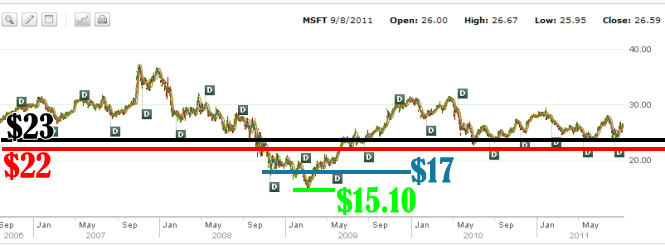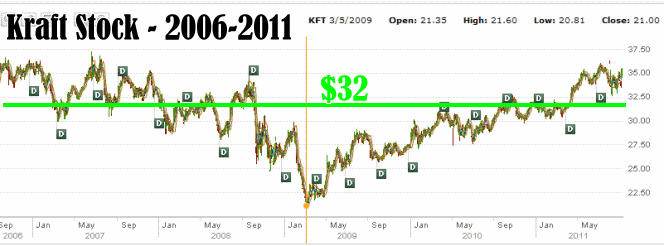On Sep 6 with the most recent selloff in stocks I once again put capital back to work in Microsoft Stock. The recent sell off in Microsoft coupled with the rise in volatility is creating some exceptional opportunities in Microsoft stock.
For example, with Microsoft stock hovering around $25.20 on Tuesday Sep 6, I sold the 17September11 $23.00 put strike for .22 cents. This is almost 1% for 9 days of risk. Microsoft stock would have to fall 8.7% to place my sold puts at the money.
The same day I also sold the October 22nd expiry $22 strike puts for .31 cents or a return of 1.3% for about 6.5 weeks of risk of assignment.
But how risky is Microsoft Stock at the present valuations?
Microsoft Stock – Sold Puts Analysis
To understand picking the put strike points to sell in Microsoft stock, let’s look back 5 years on the stock. The chart below studies the last 5 years of Microsoft stock.
Investors tend to forget to look at the history behind large cap stocks such as Microsoft. Microsoft Stock has for many investors been range bound for most of the past 5 years. Actually if we go out ten years the same is true. While many investors are upset over the apparent lack of capital appreciation in their positions, those of us who sell put options and once assigned stock, sell covered calls, are earning better than double digit returns in Microsoft. Range bound stocks are fabulous for my type of investing.
In fact Microsoft has performed better than physical gold itself over the past 8 years. I wrote this article Selling Microsoft Puts Is Better Than Gold on April 5 2011 which showed how through selling puts on Microsoft stock I have earned more than I did by holding physical gold.
Another article I wrote on April 2 2011 titled Microsoft Stock – The Ultimate Utility Stock, compared selling puts on Microsoft stock versus owning utility stocks such as Duke Energy. Suffice to say I earned double digit returns every year since 2003 on Microsoft stock. Therefore all arguing aside, Microsoft is a stock to consider for selling options and stop worrying about capital appreciation.
The 5 year chart above shows clearly why I picked the $23 strike and $22 strike for selling my most recent puts. The $22 strike has not been breached at all by Microsoft over the past 5 years except during the 2008 to 2009 market meltdown.
During that market meltdown, Microsoft stock traded below $20.00, but held quite well around the $17 strike level. The overall low during the market collapse was $15.10.
I think any viewer of the above chart would agree that Microsoft stock at $22.00 and $23.00 would be a good investment. But why buy stock when I can get the stock paid for through other people’s money. This is the whole concept behind selling the put strikes on Microsoft stock. By accumulating capital through continually selling puts and then use that capital to help pay for the shares once assigned makes a lot of sense.
Microsoft Stock – Put Strikes Are Not Randomly Sold
Since starting selling puts in 2009, I have accumulated $16,486.25 in capital through selling puts and a couple of times owning shares for a brief period before selling them. Presently I have a total capital commited of $60653.50, in Microsoft puts. By deducting the amount of capital already made, namely $16486.25 I can see that the total amount of my own capital at risk is $44167.25. Therefore if assigned on all my positions, which is a total of 2600 shares, my cost basis would be $44167.25 / 2600 = $16.98. Basically I would have a cost basis right around the $17.00 strike which is where Microsoft traded during the worst of the bear market in 2008 to 2009, aside from the meltdown period.
It is through analysis like above that I came to the conclusion of how much of my own capital to risk in my put trades. Through carefully studying stock charts over historic time periods such as market meltdowns and bear markets, I can easily justify the strikes I pick and the amount of my own capital I would place at risk. The cost basis of which I prefer to be placed in stock in the event of assignment is not random, but is by careful design.
For example, in Microsoft stock I could tell through studying the amount of my own capital that would be required, how many put contracts I can sell at what strike price. By looking back through history I know that in the event of a market calamity, I do not need to panic. If a market meltdown occured tomorrow, and I was assigned in Microsoft stock, I know from history that I have a very good chance that I could turn right around and sell covered calls to work my way back out of the stock and then repeat the process.
At the same time I know there are never any guarantees with risky assets such as stocks. If a market meltdown occured I would be giving up the $16486.25 I have already made in Microsoft stock through selling puts from 2009, but I know that fully 27% of the stock if assigned, did not cost me anything except my earnings from selling puts and that percentage will only increase with each time I am NOT assigned shares and sell more puts in Microsoft stock and earn more income.
The whole concept is to eventually own shares that cost me nothing but the capital I have earned. In other words not my original capital remains intact.
Kraft Stock Example – Stock Fully Paid Through Earnings
What about the case where a stock is entirely paid for through the puts I have sold over a period of time? For example, my Kraft Food Trades (kft), which you can review, I have earned a total of $17323.00 through selling puts. Recently I sold 5 contracts of the 22Oct11 $32 put strike. In a market meltdown I could end up owning 500 shares of Kraft stock at $32.00. However that would mean that my cost basis in the stock would be zero, yes- $0.00.
The math is simple:
$32.00 X 500 shares = $16000.00. I have earned $17323.00 to date on selling puts, so effectively the shares will cost me nothing. Imagine owning Kraft Foods (kft) stock for zero of my own capital and earning $1.16 X 500 = $580.00 in dividend payments while waiting for the stock to recover after a market collapse. Looking at the chart below, the $32.00 strike seems like decent value and $580 dividend payment on the $16000 share cost equals 3.6% annual return on capital that was not my original invested capital but other people’s money.
Microsoft Stock – Selling Puts By Design Summary
There is a lot to like about selling puts on Microsoft Stock. The best part has to be that my original capital is being returned to me each time I sell puts and that those put strikes sold are based on a time tested analysis of studying historic patterns in the stock, determining how much capital I have already earned in my put strike selling and working my cost basis in the stock to historic low levels. Microsoft stock is just one of many large cap companies I have enjoyed owning at historic low levels but it is through careful design not random put selling that I reach historic low levels in cost basis, if assigned shares in the underlying stock.
I hope other investors through reading this article will think about selling options in a different light. My Microsoft Stock trades are proof of what any investor is capable of accomplishing through a strategy that is neither complex nor difficult.



